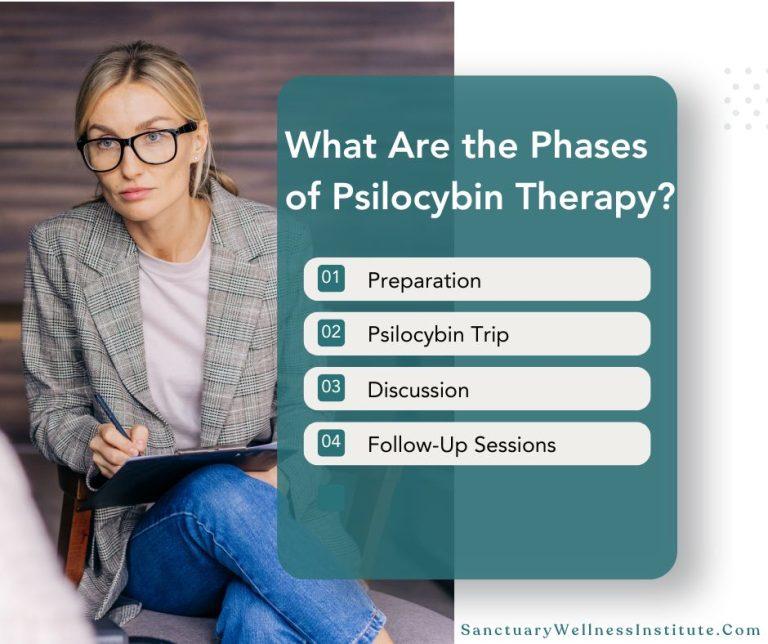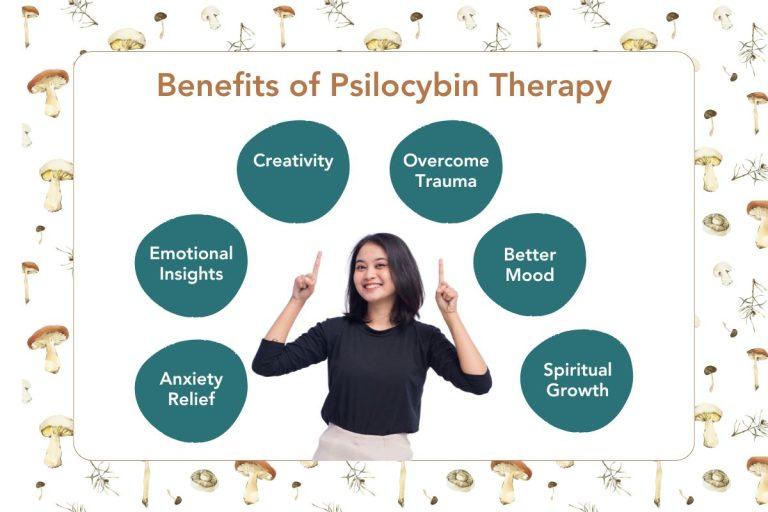What Happens in a Psychedelic Therapy Session?
- Jake Peter
- Published: February 8, 2022
- Updated: August 30, 2024
- Fact-checked by Dr. Desiree Granados

The Sanctuary Wellness Institute does not offer Psilocybin Therapy. This web page is meant for informational use only.
In recent years, psychedelic therapy has gained recognition as a groundbreaking mental health treatment. More and more people have embraced substances like psilocybin and MDMA, and many have grown curious about what actually occurs during a psychedelic therapy session. In this article, we’ll explore what psilocybin therapy is, how it works, the benefits of undergoing it, and more.
What Is Psilocybin Therapy?
Psilocybin therapy is a treatment that involves the use of psilocybin, a naturally occurring psychedelic compound found in certain mushrooms, to promote mental health and well-being. This therapy is typically conducted in a controlled setting where patients are given a specific dose of psilocybin under the supervision of trained professionals.
At its core, psilocybin therapy aims to harness the transformative potential of psychedelic mushrooms to bring about insights, emotional healing, and a greater sense of connectedness to oneself and the world.
Four Phases of a Psilocybin Therapy Session
Psilocybin therapy typically consists of four phases, each of which is designed to facilitate a safe and effective therapeutic experience. Those phases are as follows:
- Preparation: In this initial phase, the therapist and participant establish a trusting relationship. The therapist assesses the participant’s mental health history and goals for the therapy, then prepares them for the upcoming experience by helping them set intentions and addressing any concerns.
- Experience: During this phase, the participant ingests a psychedelic substance under the therapist’s guidance. The session is held in a safe, controlled environment, often accompanied by music or other calming stimuli to help the participant have a good trip.
- Integration: After the experience, integration sessions are conducted to help participants process what they experienced during the therapy. This involves discussing insights and emotional responses, as well as how they can be applied to everyday life.
- Follow-Up: The final phase consists of follow-up sessions to monitor the participant’s progress post-therapy. The therapist continues to provide support and guidance as the participant integrates their experience into their ongoing mental health journey.

Psychedelic Therapy Process
If you’re interested in psychedelic therapy using psilocybin, it’s critical to work with a professional who can develop a treatment plan that aligns with your goals and takes into account your mental health concerns. Here are a few more details about what you might expect after undergoing psychedelic therapy:
- Frequency: The frequency of psychedelic therapy sessions can vary based on individual needs and the specific therapeutic protocol being followed. Patients can undergo sessions anywhere from once a month to a few times a year. For those new to psychedelic therapy, a series of sessions—often ranging from three to six—may be recommended.
- Session duration: The duration of each session can also differ, lasting anywhere from four to eight hours depending on the substance used.
- Cost: Cost will vary based on your provider, but many psilocybin therapists charge $150-200/hour. A single session might cost $600+ and six sessions or more could cost at least $5,000 in total. A 2023 study published in Cambridge University Press suggested that psilocybin therapy is actually more cost-effective than traditional therapy for treatment of disorders like PTSD and severe depression.
When Did Psilocybin Therapy Start?
Psilocybin therapy dates back thousands of years, with indigenous cultures in Mesoamerica using psilocybin mushrooms in spiritual rituals.
Modern exploration of psilocybin as a therapeutic tool began in the mid-20th century, particularly after the discovery of its psychoactive properties in the 1950s. Around that time, researchers like Dr. Timothy Leary and Dr. Richard Alpert began to investigate psilocybin’s potential to treat various psychological conditions, such as depression and anxiety. However, research soon stalled due to regulatory pushback and the subsequent prohibition of psychedelics in the late 1960s.
In recent years, there has been a resurgence of interest in psilocybin therapy driven by promising research and evolving attitudes toward psychedelic drugs.
What Are the Benefits of Psychedelic-Assisted Psychotherapy?
Research indicates that psychedelic therapy can treat various mental health conditions, including depression, anxiety, PTSD, and drug addiction. That said, further research is needed to understand the long-term efficacy and safety of this treatment.
Some of the numerous research-backed benefits of psychedelic-assisted psychotherapy include:
- Reduced Symptoms of Depression: Many patients report significant reductions in depressive symptoms following psychedelic sessions.
- Emotional Insight: The use of psychedelics can lead to deep introspection and a better understanding of one’s emotional processes.
- Reduction in Anxiety: Psychedelic therapy can help patients manage their anxiety, particularly in end-of-life situations.
- Healthy Processing of Trauma: The altered state can create a safe space for patients to confront and process traumatic experiences.
- Openness and Creativity: Participants often experience shifts in perspective that enhance their creativity and promote openness to new ideas.
- Spiritual Growth: Some patients report spiritual insights or experiences that contribute to personal growth and well-being.
- Improved Mood: Many patients report an improved mood that lasts long after their therapy sessions.

What Are the Risks of Psychedelic Therapy?
While psychedelic therapy can serve as a viable treatment for many mental health conditions, it’s not without its risks. Some of the foremost ones include:
- Psychological Distress: Some patients may experience anxiety, paranoia, or panic attacks during or after their therapy sessions.
- Hallucinogen Persisting Perception Disorder (HPPD): In rare cases, patients may continue to experience visual disturbances long after the effects of the drug have worn off.
- Increased Blood Pressure: Psychedelics can cause temporary spikes in heart rate and blood pressure, which may be risky for individuals with cardiovascular issues.
- Substance Dependence/Abuse: Some patients may become addicted to the experience or misuse the substance(s) outside of the clinical setting.
- Interactions with Other Medications: Psychedelics may interact negatively with other medications, particularly those used for mental health treatment.
Conclusion
In summary, psilocybin therapy represents a promising frontier in mental health treatment, blending time-honored traditions with modern clinical research to create an effective therapy. While it’s important to be aware of the risks involved, there are plenty of benefits to be reaped as long as you undergo the treatment under a professional’s supervision.
How we reviewed this article:
- Richard E. Doblin, Merete Christiansen, Lisa Jerome, Brad Burge (2019). The Past and Future of Psychedelic Science: An Introduction to This Issue
https://pubmed.ncbi.nlm.nih.gov/31132970/ - Kenneth W. Tupper, Evan Wood, Richard Yensen, and Matthew W. Johnson (2015). Psychedelic medicine: a re-emerging therapeutic paradigm
https://www.ncbi.nlm.nih.gov/pmc/articles/PMC4592297/ - Anne K. Schlag, Jacob Aday, Iram Salam, Jo C. Neill, and David J. Nutt (2022).
https://www.ncbi.nlm.nih.gov/pmc/articles/PMC8905125/ - Kendra Cherry (2023). What Is Psychedelic Therapy?
https://www.verywellmind.com/psychedelic-therapy-how-does-it-work-5079161 - Paul McCrone, et al. (2023). Cambridge University Press. “Cost-effectiveness of psilocybin-assisted therapy for severe depression”
https://www.ncbi.nlm.nih.gov/pmc/articles/PMC10755218/#
Current Version
August 30, 2024
Written By
Jake Peter
Fact-checked By
Dr. Desiree Granados
Editorial Process
Our Editorial Process
First Published
February 8, 2022
Written By
Jake Peter
Fact-checked By
Dr. Desiree Granados
Editorial Process
Our Editorial Process

Jake Peter received his journalism degree from Emerson College and has been writing content for the Sanctuary Wellness Institute since 2021. He is passionate about all things cannabis.







